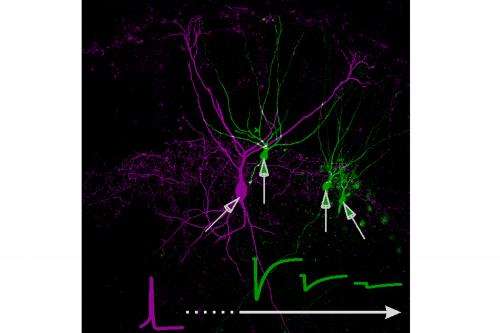Neuroscientists investigate how 100 billion nerve cells produce a clear thought or an action

We have approximately 100 billion nerve cells in our brains, all of which communicate with one another. Why do they lead to clear thoughts or purposeful actions instead of mere gibberish? The reason lies, among other things, in a small group of inhibitory nerve cells that can use the messenger GABA to curb the activity of other nerve cells. The neuroscientists Dr. Michael Strüber and Prof. Dr. Marlene Bartos from the University of Freiburg and their colleague from Vienna Prof. Dr. Peter Jonas have discovered that the distances between communicating cells play a part in the regulation of brain networks. The team presents this approach in the current issue of the journal Proceedings of the National Academy of Sciences (PNAS).
GABA is released at special contact points, synapses, from a projection of the inhibitory cells that serves precisely this purpose, the axon. The messenger causes an electrical inhibitory current in the target cells. A special subtype of the GABA-releasing cells is the so-called basket cell. It is known to have a strongly inhibitory effect on brain circuits. A reason for this is the fact that basket cells have a long and widely branching axon, with which they can control hundreds to thousands of target cells scattered over a broad area. Up to now it was not clear whether all of these target cells are subject to the same inhibitory current or whether target cells that are more distant from the GABA-releasing basket cell are more difficult to keep under precise control.
With the help of the patch-clamp technique for measuring the inhibitory currents of individual cells, the team discovered that the farther away a target cell is, the smaller and longer are their inhibitory currents. In pharmacological and electrophysiological experiments and by means of detailed microscopic studies, the neuroscientists demonstrated that the basket cell axon with more distant target cells forms less synapses and that other proteins capable of sensing GABA are found in these synapses.
What could be the reason for such a complex structure? While this question cannot be answered in its entirety, the scientists investigated the consequences of a distance-dependent inhibition in computer simulations of neuronal networks. Contrary to expectations, the weakening inhibition enables the basket cells to precisely control the activity of a large number of nerve cells and thus to synchronize them. The synchronization of entire brain areas leads to rhythmic brain activities like gamma oscillations, which serve a crucial function in higher mental processes. The new approach of distance-dependent inhibition could be an important component in the regulation of brain networks that enables the brain to orchestrate the activity of 100 billion individual yet connected nerve cells to produce a thought.
More information: Michael Strüber, Peter Jonas, Marlene Bartos. (2015) "Strength and duration of perisomatic GABAergic inhibition depend on distance between synaptically connected cells." Proceedings of the National Academy of Sciences . DOI: 10.1073/pnas.1412996112, www.pnas.org/content/early/2015/01/08/1412996112

















